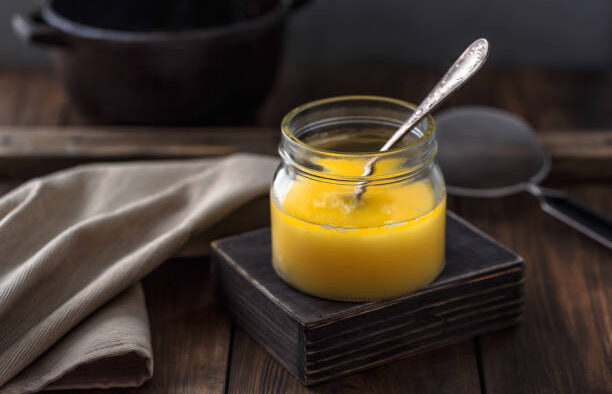When gaughrita is accompanied by specific herbs that are medhya or nourishing of the thinking mind, ghee's effects are amplified. Ghee can treat disorders and injuries of the head, brain and nervous system
The cow has been symbolized by Kamadhenu since Vedic times as the one who grants all wishes. Borne from the great ancient event of the samudra-manthana during an oceanic war, she rose from the churning of the sea and emerged as an icon of all divine virtues.
In Indian history, a cow has been valued as a mobile hospital for millenia, because its cow-derived products can cure varied ailments. Five of the many products are cow urine, dung, milk, ghee, and curd, known as the medicinal substance panchagavya. Each of these five substances is extensively elaborated in the ancient Ayurvedic texts Charaka Samhita, Sushruta Samhita and Vriddha Vagbhata, and the compound formulation of panchagavya is used for a variety of ailments.
Of the 4 types of sneha (oily medicinal substances), gaughrita is most essential for the daily diet because it provides specific fats needed for the special insulating cells of the nervous system, and it provides specific fatty acids needed by the gut microbiome.

Modern scientific analysis shows that gaughrita is composed of 99.48g of total fat per 100gm, of which 61.924g is saturated fat. Also, 256mg of cholesterol, Vitamin A 3069 IU, 4mg calcium as well as trace amounts of other vitamins and minerals.
Gaughrita is easily digestible due to its 8% lesser saturated fatty acid content compared to other edible oils or fat. It also contains vitamins A, D, E, and K. Vitamins A and K are antioxidants that prevent injury to the body by oxygen radicals. Except for fish oil, no other edible fat or oil contains vitamin A. Due to these high levels of natural antioxidants, more than any other fat or oil, gaughrita has a very long shelf life when stored in dry, cool places.
As a result of understanding that this highly unusual concentrated fat is similar to the high fats of parts of the brain, a link was established between gaughrita and the nervous system alongside the functioning of the psyche.
Beyond the chemical composition of gaughrita, Ayurvedic systems of logic also explain the vast benefits of gaughrita for the brain. Ayurveda utilizes the basic construct of saamanya and vishesha, known as the signature theory. The purpose of saamanya is to establish similarities between substances, while vishesha is to distinguish them. This theory considers three elements for defining saamanya and vishesha, which are similarities and differences in the dravya, the guna, and the karma (substances, properties and action).

An observable demonstration of similarity is lactating human mothers known to produce more breast milk if she herself drinks milk. Another demonstration of similarity is the observation that consuming meat enhances the musculature of the body, theorizing that tissues in the meat are metabolized to be similar muscles in our bodies. A demonstration of opposites or differences is the observation that activities and properties of lightness such as jogging and light foods are used to counteract the qualities of obesity and kapha which is smooth, heavy and unctuous; this promotes the quality of rukshana, which is dry, light and rough.
When involved properties need to be increased, identical dravya, guna and karma are used; when the involved qualities need to be decreased, dissimilar dravya, guna and karma are used.
This concept is particularly poignant when considering gaughrita and the nervous system. The nervous system of the body, which includes the brain, spinal cord and nerves along with all the insulation tissues of the glia and Schwann cells, has the highest fat content in the body. Adding high-quality fat that can be used by the cells of the nervous system easily, gaughrita is known to be extremely nourishing and rejuvenating for the entire nervous system.
Gaughrita crosses the blood-brain barrier due to its guna-s (properties & qualities) of penetrating into small crevices. When gaughrita is accompanied by specific herbs that are medhya or nourishing of the thinking mind, ghee's effects are amplified. Ghee can treat disorders and injuries of the head, brain and nervous system. For example, brahmi ghrita can penetrate into the blood-brain barrier and induce calm and focus. Ashwagandha ghrita can reenergize and strengthen the brain. Panchagavya too improves memory, perception, and the awareness of the mind.

While expounding the importance of gaughrita the Acharyas compared the similar properties of gaughrita to that of ojas, the resilience principle of the body, responsible for maintaining our life force. It was understood that gaughrita enhances this vital force within us, and Ojas was adopted as the indicator of healthy immunity in the body. Saying no to ghrita is saying no to the genuine golden liquid that builds your vitality.
Those seeking additional modern scientific analysis must begin with authentic cow ghrita, made properly from properly raised cows. That medicinal ghrita can be given to patients who are pre- and post-analyzed by PET Scans or by memory testing. Unfortunately, such studies are not funded because there is no proprietary potential for owning the rights to ghee. To understand the nerve of ghee and its boldness in healing the nervous system, snort 2 drops of ghee through the nostrils daily and use your own body as a laboratory. Collect pre and post-tests from several colleagues and use it as a pilot study to raise awareness on the neurologic healing potential of gaughrita.





